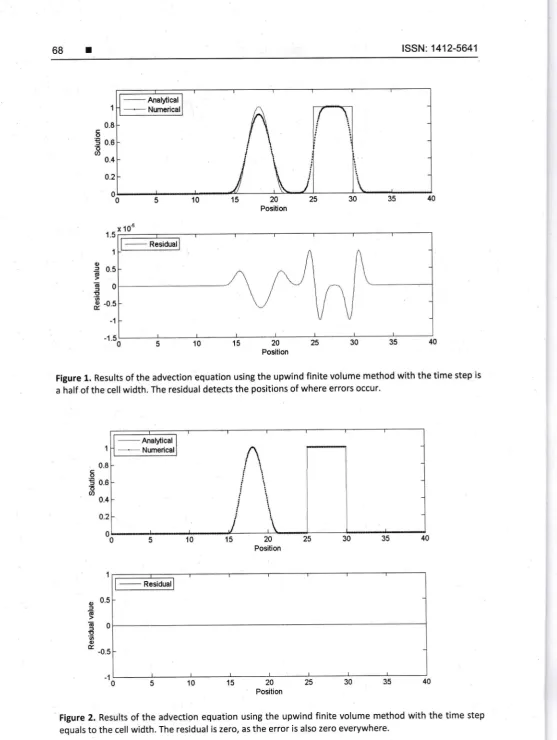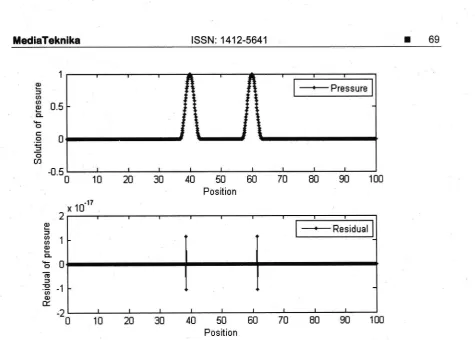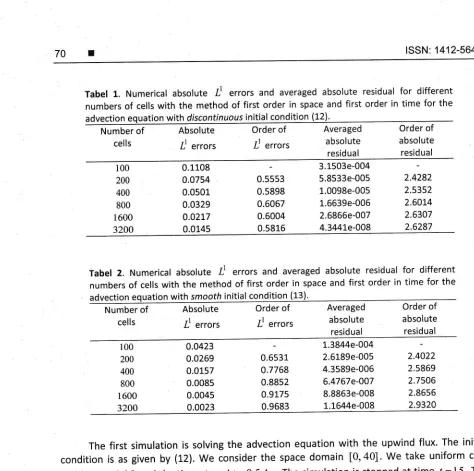Vol.
10,
No.
2,
Desember 2015
Weak
Local
Residual
in
Relation
to
the
Accuracy
of
Numerical
Solutions to
Conservation
Laws
Sudi
Mungkasi
Prototipe
Pengaturan Tekanan
Air
pada
Sistem Distribusi
Air
Renny
Rakhmawati
Penggunaan SCADA
untuk Simulasi
Pemakaian Daya, Pengendalian Pompa
Air
dan Lampu pada Gedung
Bertingkat
Budi Kartadinata, Melisa Mulyadi,
Linda
Wijayanti
Border
Gateway
Protocol
dengan Router MIKROTIK
Berbantuan
GNS3
Theresia Ghozali,
Lydia
SariImplementasi
Algoritma
Eclat
untuk
Frequent Pattern
Mining
pada Penjualan
Barang
Joseph Eric Samodra,
BudiSusanfo,
Willy Sudiarto Raharjo
Prototipe
Sistem Rekomendasi Menu Makanan dengan Pendekatan
Contextual
Model dan
Multi-Criteria
Decissio n Making
Robertus
Adi
Nugroho
Kincir
Angin
Propeler Berbahan Kayu
untuk
Kecepatan
Angin
Tinggi
Wihadi
D., lswanjono,
Rines
Evaluasi Model Pemanfaatan
Teknologi Informasi
dalam Menunjang Kinerja di
PT
Dirgantara
lndonesia
(PERSERO)
Aloysius Bagas Pradipta
lrianto,
Sasongko Pramono
H,
Wing Wahyu Winarno
tssN
1412
5641
MediaTeknika
Jurna1
Teknologi
lssN
1412 5641MediaTeknika
Volume
10 Nomor
2, Desember 2015
Dr. lswanjono
Sudi Mungkasi, Ph.D.
Johanes Eka Priyatma, Ph.D.
Dr. Linggo Sumarno
I Gusti Ketut Puja, MJ. lwan Binanto, M.Sc.
Bernadeta Wuri Harini, M.T.
Catharina Maria Sri Wijayanti, S.Pd.
Dr. Linggo Sumarno (USD)
Dr lswanjono (USD)
Dr. Pranowo (UAJY)
Y.B. Lukiyanto, MT. (USD)
Damar Widjaja, M.T. (USD)
Dr. Anastasia Rita
Widiarti
(USD)Eka Firmansyah, Ph.D. (UGM)
Risanuri Hidayat, Ph.D (UGM)
I Gusti Ketut Puja, M.T. (USD)
Contact us
:
Media Teknika Journal OfficeUniversitas Sanata Dharma
Kampus
lll
Paingan Yogyakartalelp.
(0274) 883037, 883986 ext. 2310, 2320Fax. (0274) 886s29
e-mail : [email protected]
situs
: www.usd.ac.id/mediateknikaMediaTeknika
is monoged by Faculty of Science and Technology, Sonoto Dharmo Universityfor
scientificcommunicotion in reseorch areasof engineering,technology, ond opplied sciences.
Editor in Chief
Associate Editors
Managing Editors
Administrators
lssN
1412 5647
Media Teknika
JurnalTeknologi
Vol.
10,
No.2,
2015
DAFTAR
ISIDAFTAR ISI
EDITORIAI
iiWeak Local Residual in
ielation
to the Accuracy of Numerical Solutionsto
65-7L
Conservation Laws
SudiMungkasi
ictem Distrihusi
Air
72-
82Prototipe Pengaturan Tekanan Air pada Sistem DistribusiAir
Renny Rakhmawati
penggunaan SCADA untuk Simulasi Pemakaian Daya, Pengendalian Pompa
Air
83-
91dan Lampu pada Gedung Bertingkat
Budi Kortodinoto, Meliso Mulyodi, Lindo Wiiayonti
Border Gdtewcry Protocol dengan
RouterMIKROTtK
92-
1OOBerbantuan GNS3
Theresia Ghozoli, Lydia Sori
lmplementasi Algoritma Eclat untuk Frequent Pottern Mining pada
Peniualan
101-
110Barang
Joseph Eric Samodra, Budisusanto, Willy Sudiarto Rahorio
Prototipe Sistem Rekomendasi Menu Makanan dengan Pendekatan
Contertuol
7J.1--!2LModel dan Multi-Criteria Decission Making
Robertus Adi Nugroho
Kincir Angin Propeter Berbahan Kayu untuk Kecepatan Angin
Tinggi
122-
131Wihodi D., lswanjono, Rines
Evaluasi Model Pemanfaatan Teknotogi lnformasi dalam Menunjang Kineria
di
L32-
L4OPT Dirgantara lndonesia (PERSERO)
EDITORIAL
Salam sejahtera,
Puji syukur ke hadirat Tuhan Yang Maha Kuasa atas perkenanannya Jurnal Teknblogi
Media Teknika pada tahun 2015
ini
dapat hadir kembalidi
tengah-tengah Bapak/lbu/Sdrsemuanya. Merupakan kebanggaan tersendiri bagi kami
tim
redaksi dapat melalui tahapanyang begitu rumit dan terjal, untuk mewujudkan agar jurnal
ini
bisa hadir di tengah-tengahperkembangan ipteks yang ada sekarang ini.
Jurnal Teknologi Media Teknika Vol. 10, No. 2, Desember 2015 ini memuat 8 tulisan
yang mencakup bidang
ilmu
matematika terapan1
paper, teknik elektro2
paper, teknikinformatika 4 paper dan teknik mesin 1 paper. Redaksi mengucapkan terima kasih kepada para
penulis yang telah rela meluangkan waktu dan pikiran untuk menulis paper-paper tersebut
dalam berbagi kepada yang lain. Semoga atas
jerih
payahnya mendapatkan balasan yang sepadan.Selanjutnya kami mengundang kepada Bapak/lbu/Sdr untuk turut juga berpartisipasi
dalam jurnal Media Teknika dengan mengirimkan naskah/paper hasil penelitian atau kajian
ilmiah. Kiranya tulisan Bapak/lbu/Sdr akan membantu perkembangan ipteks ke arah yang lebih
baik dan berguna bagi masyarakat.
Akhirnya
tim
redaksi berharap semoga kehadiran jurnal ini dapat bermanfaat dalammenyebarkan ipteks
untuk
membantu kepada masyarakat yang membutuhkannya. Tiadagading yang tak retak, kritik dan saran yang membangun sangat kami harapkan demi perbaikan
dikemudian hari.
Salam.
MediaTeknika J urnal Teknologi
Vol.10, No.2, Desember 2015
Weak Local Residual
in
Relation
to the
Accuracy
of
Numerical
Solutions
to
Conservation
Laws
Sudi Mungkasi
Department of Mathematics, Faculty of Science and Technology, Sanata Dharma University,
Mrican, Tromol Pos 29, Yogyakarta 55002, lndonesia
e-mail: [email protected]
Abstrod
As the exoct solutions to dilferential equotions dre generolly very difficult to find, numerical solutions are ofien desired. Numericol solutions ore approximotions to the exoct solutions, so they have
errors. Becouse we do not know the exact solutions, a tool
for
checking the occuracy of numericol solutions is needed. ln this poper, we present a formulo os the tool for investigoting the occuracy ofnumerical solutions to conservotion lows. The formula is derived from the weok local residual of the numerical solution. The residual is zero if the solution is exoct. The lorger the residuol meons the less
occurate the approximate solution. We consider two specific conservation laws, namely the advection equation and the ocoustics equations. With these two problems, our results show thot the weak local residuol behaves correctly os on occurocy-checking form.ulo of numerical solutions to conservation laws.
Keywords: accurocy-checking formula, conservotion laws, finite volume methods, weak local residuol
l.lntroduction
Differential equations have important roles in mathematical modelling of real problems,
such as fluid flows, wave propagation, weather prediction, etc. Differential equations need to be solved to find the solution to the real problems. Solving exactly the equations is generally difficult. Therefore numerically solving the equations is an option that can be considered.
Numerical solutions are approximations of the exact solutions. We are interested in a
way
to
checkthe
accuracyof
numerical solutionsto
conservation laws, wherethe
exactsolutions are
not
known dueto
their
difficultyto
find. Conservation laws themselves havemany applications in
fluid
and solid dynamics modelling. Therefore, they are important tostudy.
Some numerical techniques
for
solving conservation laws have been availablein
theliterature for years. One of them is the finite difference method, which is powerful for smooth
solutions. Conservation laws can be hyperbolic, so they admit discontinuous solutions. This
means that conservative methods are needed for solving conservation laws accurately. One of
conservative methods is the finite volume method which is implemented in this paper to solve
conservation laws. The resulting solutions still have errors, but we do not know the magnitude
of the errors, because once again we do not know the exact solution.
To know the magnitude of the errors, a formula is needed. We propose the use of the
weak local residual formula in order
to
investigate the accuracyof
numerical solutions. Our formula follows from the work of Constantin and Kurganov [1] as well as Mungkasi et al.121. The formula is explicit. lt is simple to compute at alltime, but the residual formula is valid only for conservative numerical methods [3].This paper
is
structured as follows.We
presentthe
formulationof the
weak localresidual
in the
next section.After
that
we test
the
performanceof the
formulafor
theISSN: 1412-5641 66
2. Weak local Residual Formulation
Consider the scalar conservation laws in the form
with initial condition
(1)
(2)
acoustics equations. The
(3)
(4)
(s) aq
*a.f!il
. 0,
_co<x<co
0t
0xq(x,t):eo(x),
t=0.
Here variable
x
represents the space and variable,
denotes the time. The quantity q =q(x,t)
is conserved. The function q(x,O)=
Qo(x) is given. The functio nf
= .f(q(x,t))
is the flux'We consider
two
problems, namely the advection equation and theadvection equation is
dn
*an
=0.
dax
where
the
conserved quantity q =q(x,t)
is transportedto
the
right directionwith the
unit velocity. The (constant-coefficient) acoustics equations are@*
nr4=0.
dt
Ox0,
*l
0,
=0.
&
pAx
Here in the acoustics equations:
.
p =p(x,t)
represents the Pressure,.
l.t=u(x,t)
is the velocity variable,.
p
is the density which is assumed to be constant, andc
is the pressure wave propagation speed, which is also assumed to be constant'Let us consider
a
conservative numerical methodto
solvethe
conservation laws' lnparticular, let us take a standard finite volume method. ln the standard finite volume method,
ih.
,p...
domain is discretised into a finite number of cells with the cellwidth
Ax. The timedomain is dicretised into a finite number of time steps
ar,
where the valueof Ar
is chosensuchthatthemethodisstable.Thecentroidsof
cellsaredenotedx,,with
xi*ti=x,+Ar'The
vertices
of
cells are denotedxi+t/z1=x,+Lxl2.
The discretetime
is denoted ,n+t'={
+N
'The notatio n ,n+tt2 means ,n+rt2 '.- t" + Lt
/2
'The weak local residual for the conservation laws (1) with initial condition (2) has been formulated by Constantin and Kurganov [1] and is given by
*r;i']
=*lni
- qi-'
+
qi-,-
qii'f*flr<nr;'t-
-f@i\+
f
@i,,)-f(q)\'
6)
This formula is derived from the weak formulation of the conservation laws as follows. First we
write the initial value problem (1)-(2) in the weak
form
'r\i_l^.,rUy+
f
@(x,fi{ff)*
o,+iao@)rtx,,)
dx=,
,
(7)
with
T(x,t)
is a test
function.ln this
work
we
take
the test
function
at
every point(xi+ttz,t'-tt2) as
T ( x, t)' = T'i-r|r' (*, t)
:
B i *r r z(x)B"-"'
(t),
where
MediaTeknika Vol. 10, No. 2, Desember 2015: 65
-
7'lHedlaTeknlka ISSN: 1412-5641 67
U-,,r,',
=1
x-x,,,.
A,
xi+3/z
-
xAr
0
if
xr-r12('x3
xia112 ,if
x,*r,r3x3xi412,
otherwise.
(e)
and
, - ,n-3t 2
ig
gn-3t2St
Stn-r,2,
Bn-tt21t1=
Lt
,n+llz _,
i1
,n-1/2 <rqrn+ttzLt
0
otherwise.Substituting this test function into the weak form (7) of conservation laws, we obtain
Ni',','
=
l*[',.
ji,',lr*,t){&t9o*
r@(*ilryo)*a,,
(11)which
resultsin the
Constantin-Kurganov residual formulation(5), as
also discussed byMungkasi et ol. 121. Note that if the right hand side of equation (1) is not zero, the formulation
of the weak local residual needs to be well'balanced [4].
3. Numerical Tests
ln this
sectionwe
presentour
numerical results. We assumethat
all
quantities are measured in Sl units. We consider three initial conditions as follows for our test cases:.
a non-smooth initialconditionif
0<x<2tt,
if
2n<x<I0,
if
10<x<15,
if
15<xS40
for the advection equation,
o
a smooth initialcondition./-.
^\_
[O.S(l+cos(x))
if
0<x<Ztt,
4(x'u)=t
o
it
2n<x340,
for the advection equation,
.
an initial condition together withz('r'0) = 6
'
[1+cos(x-50)
if
50-n<x<50+2,
P(x'0) =
i
L 0
if
OSx<50-t
w
50+tr<x<100.
for the acoustics equations.
The numerical methods used
for
our simulations arefirst
orderfinite
volumeNext, we report four simulations to achieve our goal.
methods [5]. (10)
(12)
(13)
(14)
(1s)
6B ISSN: 1412-5641
1
0.6 0.6 0.4 o.2
0
0
15
20
25Position x 104
1.5r-o
f d
E
f !,
c)
v.
I
0.5
0
-0.5
-1
-1.5
-
Residual
[image:8.612.30.588.19.759.2]20 Position
Figure 1. Results of the advection equation using the upwind finite volume method with the time step is
a half of the cell width. The residual detects the positions of where errors occur.
-
Residual
20 Position
Figure 2. Results of the advection equation using the upwind finite volume method with the time step
equals to the cell width. The residual iS zero, as the error is also zero everywhere'
30 25
't5
10
15
2A
25 Position1
,
0.5a
6
Eo
!,'6 o*
-0.5
-1
30 15
10
lledlaTeknika
ISSN: 1412-5641 69810
x 1o-17
Residual
10 20 30 4U 5U 60 70 B0 90
180 [image:9.545.27.503.24.364.2] [image:9.545.47.516.401.713.2]Position
Figure 3. Pressure solution of the acoustics equations obtained using the Lax-Friedrichs finite volume method with the time step equals to the cell width, As the numerical solution is exact, the residual is
zero everywhere up to the machine precision. The magnitude of the residual is in the scale of 2.Oe-17 .
1 OT
u,
E
o.E o-oEo
=
c, m -tl.5 2 1 (lJ U' o o, L EL oE
=
vt oJ E >1 .=o g o} c, L .EE
t/l -(J EE
(fE
==
art o} E40 5U
E0Position
*Velocity
10u g0 BB 70 30 20 1 8.5 0 -0.5 -1 1 0.5 0 -0.501u
-dx10'
40 50
E0Fosition 1Uu 90 Eu 70 30 2E _1t
B 10 2B
30 4U 50 6U 78 BB
90 100Position
Figure 4. Velocity solution of the acoustics equations found using the Lax-Friedrichs finite volume method with the time step equals to a half of the cell width. The residual finds the places where large
errors occur. The magnitude of the residual is in the scale of
l.0e-4.
70 ISSN: 1412-5641
Tabel 1. Numerical absolute -C
"rrorr
and averaged absolute residualfor
differentnumbers of cells with the method of first order in space and first order in time for the advection equation with drscontinuous lnllel lenqlllen-ll?L
Number of
cells
Absolute
I
etrortOrder of
/
etrortAveraged
absolute
residual
Order of absolute residual 100 200 400 800 1600 3200 0.1108 o.o754 0.0501 0.0329 0.02L7 0.0145 0.55s3 0.5898 0.6067 0.5004 0.5816 3.1503e-004 5.8533e-005 1.0098e-005 1.6639e-005 2.6866e-007 4.3441e-008 2.4282 2.5352 2.6014 2.6307 2.6287
Tabel 2. Numerical absolute -C errors and averaged absolute residual
for
different numbers of cells with the method of first order in space and first order in time for the advection equation with srnooth initial condition (13Number of
cells
Absolute
-C
"rrort
Order of
/
etrottAveraged
absolute
residual
Order of absolute residual 100 200 400 800 1600 3200 o.0423 0.0269 0.0157 0.008s 0.0045 0.0023 0.6531 0.7768 0.8852 0.9175 0.9683 1.3844e-004 2.6189e-005 4.3589e-006 6.4767e-007 8.8863e-008 1.1644e-008
z.iozz
2.s869 2.7506 2.8656 2.9320The first simulation is solving the advection equation
with the
upwind flux. The initialcondition is as given by (12). We consider
the
space domain [0,40].
We take uniformcell-width
Ax = 0.05 and the time step A/ = 0.5 Ax . The simulation is stopped attime
/:
15 . Theanalytical solution of this problem can be found from the work
of
LeVeque [5]. We find thatthe largest errors occur at around discontinuities, as shown in Figure 1. ln Figure 1 we can also
observe that
the
residual values areat
around discontinuities. This means thatthe
residual concludes the same behaviour as the error.ln
the
second simulation, we modify the time step of the first one' Now we take thetime step
to
be Af = Ax. Based on the characteristics method, the finite volume method withthe upwind flux formulation results in the exact solution. lndeed, we find the exact solution.
That is,
our
numerical solution matches exactlywith
the
analytical solution, as plotted inFigure 2. As shown in Figure 2, we also observe that the residual values are zero everywhere.
This means that the residual behaves the same as the error.
The
third
simulation is about solvingthe
acoustics equations. We considerthe
initialcondition (14)-(15).We consider
the
spacedomain [0,100]. We take
uniform cell-widthAx:0.1
and the time stepN =
Lx. We use the finite volume method with the Lax-Friedrichsflux.
Basedon
the
characteristics theory[5],
the
method resultsin the
exact (analytical)solution. However, we do not know the explicit form of the analytical solution. This is a good
test case if the residual for:mula can give the correct indication of the exact solution- At time
t=lO,the
simulation results are given in Figure 3. ln this figure there are two waves, that is,one moves to the left and one moves to the right. The residual values are below the machine
precision (less
than 2xl0"r7l,
as shown in Figure 3. This means that our numerical solution isactually the exact solution up to the machine precision.
[image:10.582.29.503.21.492.2]MediaTeknika ISSN: 1412-5641
The fourth simulation is similar to the third one, but in this fourth simulation we change
the time step
to
A/ = 0.5Ar.
Of course we shall not obtain the exact solution in this case. Thepoint of this simulation is
to
make sure that the residual can still detect where the positions have errors inthe
numerical solution. As shownin
Figure 4,the
residual indicatesthat
thelargest errors occur at positions around large wave amplitudes. The error gets larger as time
evolves. This is because the amplitudes of waves, both moving to the left and right, dampen.
To complete our work, we investigate
the
behaviourof the
residual asthe
grids arerefined. Firstly we consider the advection equation with initial condition (12) solved using the upwind finite volume method
with
&
= 0.5 Ax. The order of accuracy (order of error) is about0.6, whereas
the
orderof the
residual isabout
2.6,
as recorded in Table 1. Secondly weconsider
the
advection equationwith
initial
condition (13) solved usingthe
upwind finitevolume method
with
A/ = 0.5 Ax, the same time step value as before. The order of accuracy(order
of
error) isabout
1, whereasthe
orderof
the
residual isabout
3,
as recorded in Table 2. The order of error is larger for Table 2 than for Table 1, because of the difference intheir
initial conditions. The smootherthe
solution givesthe
largerthe
orderof
error. Thisphenomena is also reflected in the residual results, shown in Tables 1 and 2.
4. Conclusion
Weak local residual has been shown
to
be
powerfulin
checkingthe
accuracy ofnumerical solutions where the exact solutions are
not
known. The behaviour of the residualmimics that of the error. These results may help in the construction of smoothness indicator or
discontinuity detector
of
numerical solutions. Regionsof
where
numerical solutions areaccurate and
not
accurate can be identified usinga
smoothness indicatoror
discontinuitydetector.
References
11] Constantln LA, Kurganov A. Adaptive central-upwind schemes for hyperbolic systems of conservation laws. ln
F. Asakura et al., eds., Hyperbolic Problems: Theory, Numerics, and Applicotions, Vol. 1, pages 95-103. Yokohama Publishers, Yokohama, 2006.
t2l
Mungkasi S, Li Z, Roberts SG. Weak local residuals as smoothness indicators for the shallow water equations. Applied Mothemotics Letters. 2014; 30: 51-55.t3J Dewar J, Kurganov A, Leopold M. Pressure-based adaption indicator for compressible Euler equations. Numericol Methods for Portiol Differentiot Equotions.2015; 31: t84q-1874.
t4]
Mungkasi S, Roberts SG. Well-balanced computations of weak local residuals for the shallow water equations,ANZTAM Journol. 2Ot5; 55: C72*C!47 .
tsl
LeVeque RJ. Finite-volume methods for hyperbolic problems. Cambridge: Cambridge University Press. 2004.71
Weak Local Residual in Relation to the Accuracy..., Sudi Mungkasi


